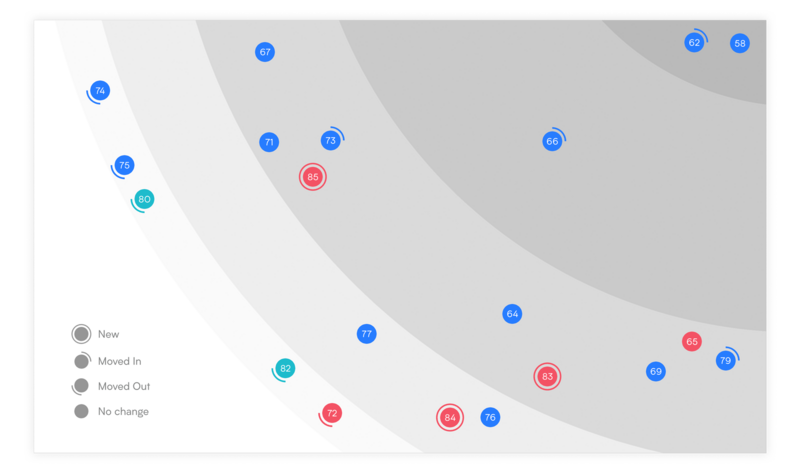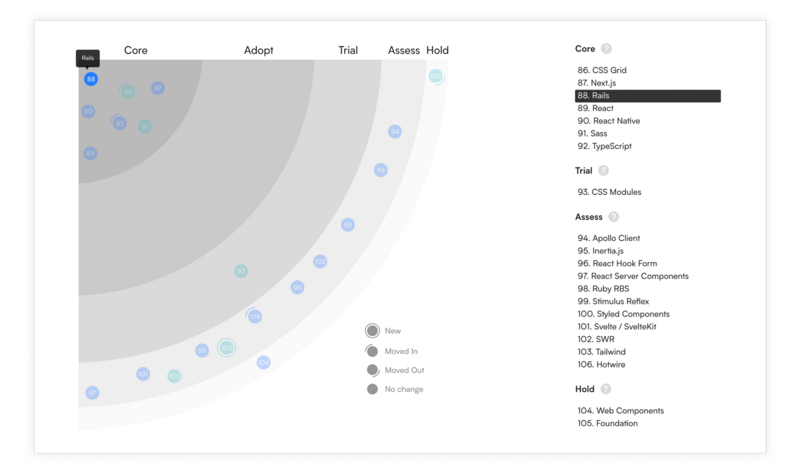It goes without saying that as a technology agency we need to be acutely aware of the tech landscape, particularly around design and engineering. With emerging languages, methodologies and processes appearing from all corners of the industry, it’s down to us to analyse how they fit amongst the work that we do as an organisation.
There’s no shortage of conversations around technology on any given day at Kyan. That could be during a standup, on a client call, during a Dev Meet, or even by the coffee machine. Whilst technology clearly excites us and drives us forward, we needed a more formalised way to track what we are using, what’s emerging and what the various sectors that we work in are talking about. Enter the TECH RADAR! 💥

What is a Tech Radar?
We were initially inspired by Thoughtworks, an Australian technology consultancy who open-sourced the code for their own Technology Radar. Their BYOR (Build Your Own Radar) tool begins with a spreadsheet or CSV file, and with some JavaScript magic, becomes a clean and intuitive browser-based UI.
With our data and some front-end love, we were able to Kyan-ify the radar and make it our own. We currently have 106 data points spread across the radar, but thanks to some clever categorisation and colour-coding, that’s not nearly as chaotic as it might sound.
Stages, teams, quadrants and status
At a top level, we’ve split our radar into four quadrants: techniques, platforms, tools and languages & frameworks. Those quadrants are home to a broad range of things from design sprints and accessibility through to TypeScript and OpenAI. We drill down once again to separate the tech in each quadrant by the relevant Kyan teams: Design, QA and Engineering.
The wider circle (and thus, each quad) is divided into five successive stages, which are as follows:
Hold – It's likely we've found an alternative that we prefer for new projects, or there are concerns about whether this is right for Kyan.
Assess – We're interested in understanding whether this is something worth trialling. A typical assessment might be a 'hello world' and a dev talk.
Trial – We've assessed this and think it's worth trialling on a small, low risk project. Internal projects are ideal.
Adopt – Under the right circumstances, we think this is ready for client projects.
Core – Central to the work we do at Kyan. Can be used on any project.


An example of ‘Hold’ might be Sketch, the design application. This is in ‘Hold’ because we now favour Figma as our go-to app for design and UI work. A quarter line towards the outside of the quadrant (which you'll see on some of the circles above) indicates that it’s moved outwards. Sorry, Sketch.
An example of ‘Core’ is Lighthouse, an automated tool for improving the quality of web pages. The quarter line is at the opposite side to Sketch (towards the inside of a quadrant), which shows that it’s moved inwards as we’ve adopted it as a core tool in our QA workflow.
There are two other statuses applied to the dots: a full circle, which denotes ‘newness’, and no circle, which simply means ‘no change’.
Powered by people
Obviously, the Tech Radar isn’t quite AI just yet. It’s powered by inputs from heads of our tech team, Nick Linnell, Head of Engineering, and Tom Marshall, Head of Technology. Between them, they’re able to keep an eye on the tech landscape as a whole, and also catch-up with various Kyan people across our design, engineering and QA to not only see what’s hot and what’s not, but discover what individual designers or engineers would like to see more (or less) of.

Future armour
Our Tech Radar has been a great exercise in assessing the Kyan wheelhouse. It’s also been a brilliant internal project to put some of our best brains onto. But for the most part, it allows us to stay ahead of the curve when it comes to technology, applications, techniques and frameworks.
This isn’t necessarily just for the tech that we feel we should be using because our work, clients or projects dictate it, but also for the tech that we’d like to be using. Because after all, technology is in our DNA, and the thrill of it is not knowing what’s just around the corner.
You can check out our Kyan Tech Radar on GitHub, and you can build your own with Thoughtworks’ BYOR tool.
Our Tech Radar team:
Tom Marshall, Head of Technology
Nick Linnell, Head of Engineering
Dave Quilter, Software Engineer
Josh Jimenez Bedrock, Software Engineer
Rob Wills, Creative Developer
We are Kyan, a technology agency powered by people. And radars.



